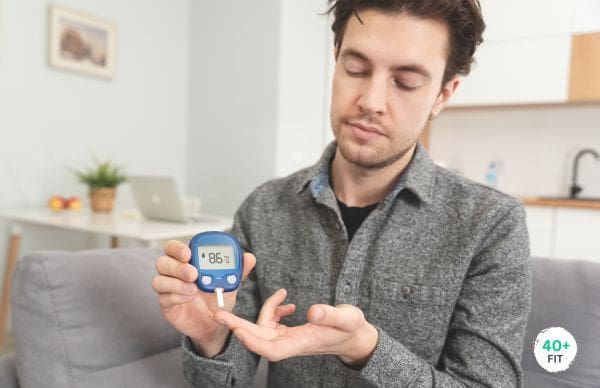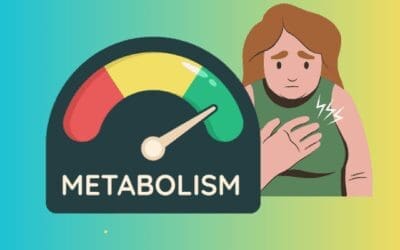Understanding Your Blood Sugar: Keeping Your Energy Levels Up After 40
Ever felt sluggish after a big lunch or experienced a dip in energy mid-afternoon? It could be your blood sugar talking to you.
Blood Sugar: The Body’s Fuel Gauge
Imagine your blood sugar as the gasoline that keeps your body running. Our bodies convert the food we eat, especially carbohydrates, into a simple sugar called glucose. This glucose is then transported through the bloodstream to our cells, where it’s used for energy.
Why Keeping Blood Sugar Balanced Matters
Think of your blood sugar levels as an ideal speed limit on a highway. When things are running smoothly, the traffic (glucose) flows efficiently, delivering energy to your cells for all your daily activities.
However, just like rush hour traffic jams, blood sugar levels can get out of whack. When you eat sugary foods or refined carbohydrates, your blood sugar spikes rapidly. This can leave you feeling jittery and full of energy for a short time, but it’s often followed by a crash, leading to fatigue and cravings.
The Age Factor and Blood Sugar Regulation
As we hit our forties, our bodies become less efficient at managing blood sugar. Our cells may become less responsive to insulin, a hormone that helps unlock the door for glucose to enter the cells. This can lead to chronically high blood sugar levels, a condition known as prediabetes or type 2 diabetes.
The Potential Risks of Uncontrolled Blood Sugar
Leaving high blood sugar unchecked for extended periods can increase your risk of developing serious health problems down the line, such as heart disease, stroke, nerve damage, and vision problems.

The A1C Test: A Snapshot of Your Blood Sugar Control
What is the A1C Test?
The A1C test is like a report card for your blood sugar control. It measures the average amount of glucose attached to your red blood cells over a two- to three-month period. This test helps doctors assess your risk for developing diabetes and monitor your blood sugar management over time.
Where can you get an A1C Test done?
As this may vary depending on your country, I can only provide some helpful information to guide you in finding a place to get an A1C test done. Here are a few options:
- Your Doctor’s Office: This is often the most convenient option. Many doctors routinely perform A1C tests during regular checkups.
- Laboratory Testing Facilities: Independent labs offer A1C testing, sometimes without a doctor’s referral required.
- Retail Clinics: Some larger pharmacies or retail clinic chains may offer A1C testing. Check with your local pharmacy or search online for availability.
Insurance Coverage:
Most health insurance plans cover A1C testing, but it’s always a good idea to check with your insurance provider beforehand to confirm coverage and understand any potential out-of-pocket costs.
Taking Charge of Your Blood Sugar Naturally
The good news is, there are plenty of things you can do to keep your blood sugar in a healthy range and feel energized throughout the day, even after 40. We’ll explore these natural strategies including how to lower a1c naturally in the next sections, so stay tuned!

Fueling Your Body for Balanced Blood Sugar
Now that we understand the importance of keeping blood sugar in check, let’s dive into how your diet can play a starring role.
The Power of Plate Planning
Imagine your plate as a canvas for creating balanced meals. Here are some key principles to keep your blood sugar happy:
- Portion Control is King: Half your plate should be filled with non-starchy vegetables like leafy greens, broccoli, or peppers. These are low in calories and carbohydrates, keeping your blood sugar from spiking.
- Fiber is Your Friend: Fill a quarter of your plate with whole grains like brown rice, quinoa, or whole-wheat bread. These are packed with fiber, which slows down the digestion of carbohydrates and helps prevent blood sugar spikes.
- Lean Protein Power: The remaining quarter of your plate is prime real estate for lean protein sources like grilled chicken, fish, beans, or lentils. Protein keeps you feeling fuller for longer and helps regulate insulin release, further promoting blood sugar balance.
Fiber: Your Blood Sugar Superhero
Think of fiber as a natural sponge in your digestive system. It helps slow down the absorption of sugar from your food, keeping your blood sugar levels steady and preventing those unwanted crashes. There are two main types of fiber:
- Soluble Fiber: This magical fiber forms a gel-like substance in your gut, further slowing down sugar absorption. Examples include oats, flaxseeds, apples, and Brussels sprouts.
- Insoluble Fiber: This type of fiber adds bulk to your stool and keeps things moving smoothly. It’s found in whole grains, vegetables, and nuts.
Carbs: Not All Created Equal
Carbohydrates get a bad rap sometimes, but they’re an essential source of energy for our bodies. The key is choosing the right types.
Here’s where the glycemic index (GI) comes in. The GI ranks carbohydrates based on how quickly they raise your blood sugar. Low-GI carbs are digested slowly, causing a gentle rise in blood sugar. Examples include whole grains, fruits with the skin on (apples, pears), and legumes.
High-GI carbs, like white bread, sugary drinks, and processed snacks, are digested rapidly, leading to blood sugar spikes and crashes.
Sweet on Protein: Your Blood Sugar BFF
Protein isn’t just for building muscle. It also plays a vital role in blood sugar control. Including lean protein sources in your meals and snacks helps you feel satisfied for longer, preventing you from reaching for sugary treats. Additionally, protein helps regulate insulin release, further promoting balanced blood sugar levels.
Healthy Fats: Don’t Be Fooled by the Name
Healthy fats are your friends when it comes to blood sugar management. They slow down the absorption of carbohydrates and can even improve insulin sensitivity. Think avocados, nuts, seeds, and olive oil.
Incorporate these healthy fats into your meals by adding a drizzle of olive oil to salads, enjoying a handful of almonds for a snack, or topping your morning oatmeal with chia seeds.
Sugar, the Sneaky Culprit:
It’s no secret that added sugar can wreak havoc on your blood sugar. But sugar can hide in many places you wouldn’t expect, like processed foods, salad dressings, and even some yogurts.
Here are some tips for reducing added sugar intake:
- Become a Label Detective: Reading food labels is your best defense against hidden sugars. Look for “added sugar” on the ingredient list and choose products with lower sugar content.
- Swap Sugary Drinks for Water: Ditch sugary sodas and juices for water, the ultimate sugar-free beverage. Aim to drink plenty of water throughout the day to stay hydrated and support blood sugar control.

Move Your Body, Manage Your Blood Sugar
Diet plays a crucial role in blood sugar control, but don’t underestimate the power of exercise! Physical activity is a fantastic tool for keeping your blood sugar balanced and your energy levels up.
Exercise: Your Blood Sugar Ally
Here’s why getting your body moving is so beneficial for blood sugar management:
- Boosts Insulin Sensitivity: Think of insulin as the key that unlocks the door for glucose to enter your cells. Exercise improves your body’s sensitivity to insulin, allowing your cells to absorb glucose more efficiently, leading to lower blood sugar levels.
- Burns Extra Glucose: Exercise is like a furnace for excess glucose. When you’re active, your muscles use glucose for energy, helping to keep your blood sugar from spiking.
Finding Your Fitness Groove
The good news is, you don’t need to become a gym rat to reap the blood sugar benefits of exercise. The key is to find activities you enjoy and incorporate movement into your daily routine. Here are some ideas to get you started:
- Brisk Walking: This simple yet effective exercise is a great way to get your heart rate up and burn some glucose. Put on your walking shoes, explore your neighborhood, or walk during your lunch break.
- Cycling: Whether you hit the road or hop on a stationary bike, cycling is a low-impact exercise that’s easy on your joints yet effective for blood sugar control.
- Swimming: This full-body workout is refreshing and gentle on your joints. Swimming engages various muscle groups, helping your body utilize glucose for energy.
- Dancing: Put on your favorite tunes and get your groove on! Dancing is a fun way to get active and burn calories, all while managing your blood sugar.
Strength Training Matters Too
Don’t underestimate the power of strength training for blood sugar control. Building muscle mass increases your body’s ability to use glucose for energy, even at rest. Start with bodyweight exercises like squats, lunges, and push-ups, or consider consulting a trainer for a personalized plan.
Consistency is Key
Remember, the magic lies in consistency. Aim for at least 30 minutes of moderate-intensity exercise most days of the week. Even small bursts of activity throughout the day can make a difference. Take the stairs instead of the elevator, park further away from your destination, or do some quick stretches during your commercial breaks.
Lifestyle Habits for Balanced Blood Sugar
While diet and exercise are the cornerstones of blood sugar control, other lifestyle habits can significantly impact your success.
Sleep for Success
When you’re sleep-deprived, your body struggles to regulate hormones like insulin, leading to higher blood sugar levels. Aim for 7-8 hours of quality sleep each night. Develop a relaxing bedtime routine, create a sleep-conducive environment, and limit screen time before bed.
Stress Less, Manage Blood Sugar Better
Chronic stress can wreak havoc on your blood sugar. When stressed, your body releases hormones like cortisol, which can increase blood sugar levels. Find healthy ways to manage stress, such as yoga, meditation, deep breathing exercises, or spending time in nature.
Mindful Eating: Savor Your Food
In today’s fast-paced world, it’s easy to mindlessly eat while working, watching TV, or scrolling through your phone. This can lead to overeating and imbalanced blood sugar levels. Practice mindful eating: focus on your food, savor each bite, and eat slowly, allowing your body to register fullness cues.
Taking Control of Your Blood Sugar Naturally
Remember that feeling sluggish after lunch or experiencing that afternoon energy dip? By incorporating these natural strategies, you can keep your blood sugar in check and feel energized throughout the day.
Small Changes, Big Impact
Making small, sustainable changes to your diet, exercise routine, and lifestyle habits can significantly impact your blood sugar control. Don’t feel overwhelmed by trying to overhaul everything at once. Start with one or two changes you can realistically integrate into your daily life. Gradually build on your successes, and celebrate every milestone along the way.
Building a Personalized Plan
There’s no one-size-fits-all approach to blood sugar management. What works wonders for your friend might not be the best fit for you. Experiment and find what works best for your body and preferences. Explore different healthy recipes, discover physical activities you enjoy, and prioritize relaxation techniques that help you manage stress.
Seeking Professional Support
If you’re concerned about your blood sugar levels or have any questions, don’t hesitate to consult your doctor or a registered dietitian. They can provide personalized guidance, monitor your progress, and offer support on your journey to healthy blood sugar control.
Empowering Each Other: Share Your Journey
You’re not alone in this! Many people are taking charge of their health and managing their blood sugar naturally. Share your experiences, tips, and challenges in the comments section below. Together, we can create a supportive community and empower each other to live healthier, happier lives.






